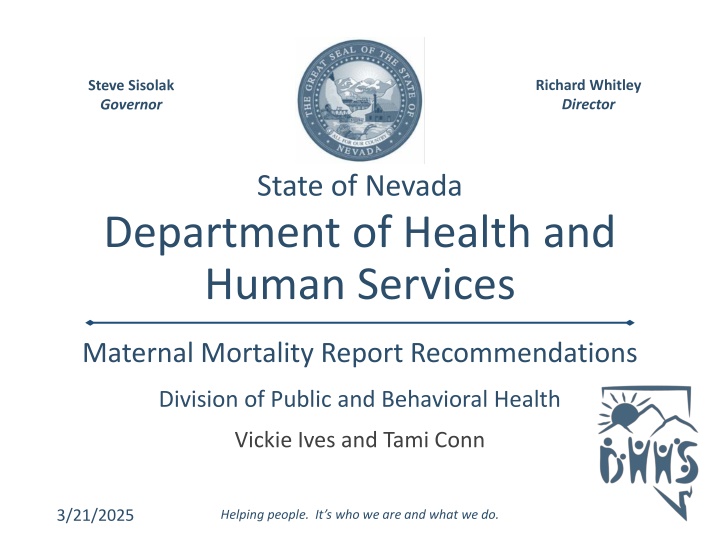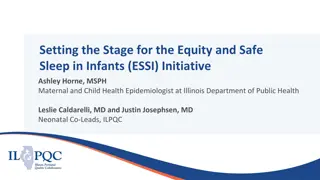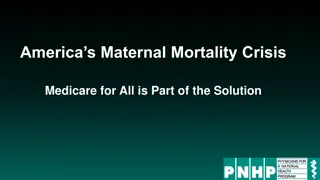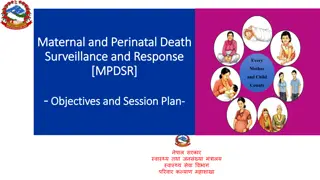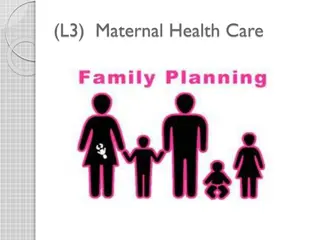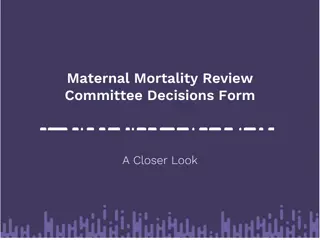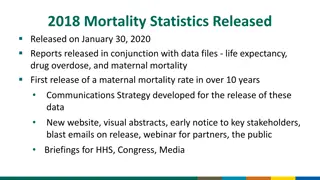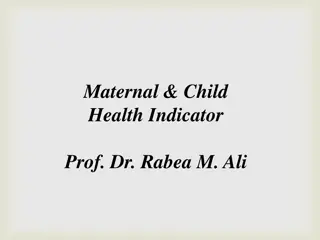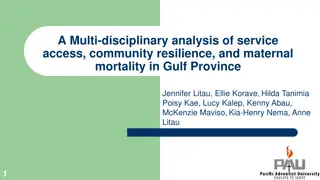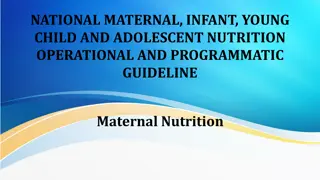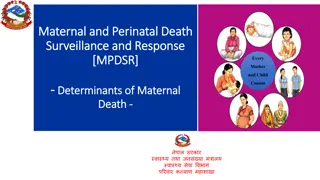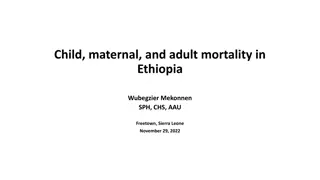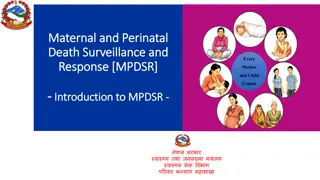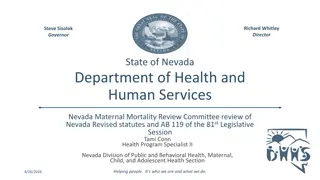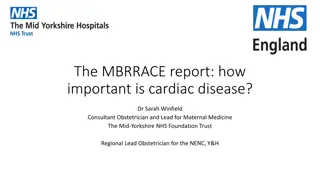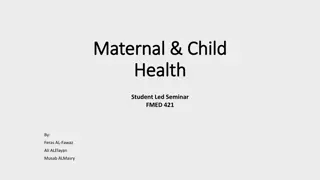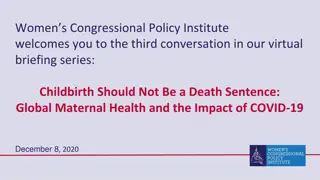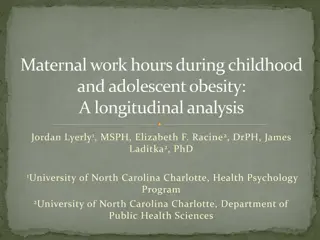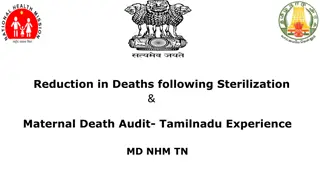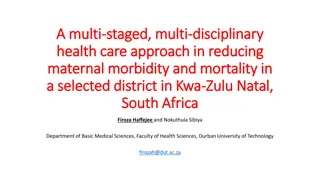Maternal Mortality Review Committee Overview
Maternal Health, Nevada, Public Health, Maternal Mortality
Download Presentation

Please find below an Image/Link to download the presentation.
The content on the website is provided AS IS for your information and personal use only. It may not be sold, licensed, or shared on other websites without obtaining consent from the author.If you encounter any issues during the download, it is possible that the publisher has removed the file from their server.
You are allowed to download the files provided on this website for personal or commercial use, subject to the condition that they are used lawfully. All files are the property of their respective owners.
The content on the website is provided AS IS for your information and personal use only. It may not be sold, licensed, or shared on other websites without obtaining consent from the author.
E N D
Presentation Transcript
Richard Whitley Director Steve Sisolak Governor State of Nevada Department of Health and Human Services Maternal Mortality Report Recommendations Division of Public and Behavioral Health Vickie Ives and Tami Conn 3/21/2025 Helping people. It s who we are and what we do.
Agenda Maternal Mortality Review Committee (MMRC) and Advisory Committee for the Nevada Office of Minority Health and Equity (NOMHE) Reporting and Recommendations Office of Analytics Draft Data Report Summary of MMRC Draft Recommendations Solicitation of NOMHE Advisory Committee recommendations 2
Maternal Mortality Review Committee Overview Maternal Mortality Review Committees (MMRCs) review deaths within one year of pregnancy to drive recommendations and actions to eliminate preventable maternal mortality and address disparities. MMRCs address the question on a case-by-case basis, If they had not been pregnant, would they have died? Per the Centers for Disease Control and Prevention (CDC), 63% of pregnancy-related deaths are preventable. (Based on results obtained from 14 MMRCs by Davis, et al, 2019). The Nevada MMRC reviews all incidences of maternal mortality in Nevada, regardless of the cause of death. 3
MMRC and NOMHE Advisory Committee Report From NRS 442.767 1(f) On or before December 31 of each even-numbered year and in collaboration with the Advisory Committee of the Office of Minority Health and Equity of the Department and the Chief Medical Officer, develop and submit to the Director of the Legislative Counsel Bureau for transmittal to the next regular session of the Legislature a report that includes, without limitation: (1)A description of the incidents of maternal mortality and severe maternal morbidity reviewed pursuant to paragraph (a) and subparagraph (1) of paragraph (c), respectively, during the immediately preceding 24 months, provided in a manner that does not allow for the identification of any person; (2) A summary of the disparities identified and reviewed pursuant to subparagraph (2) of paragraph (c); (3) Plans for corrective action to reduce maternal mortality and severe maternal morbidity in this State; and (4) Recommendations for any legislation or other changes to policy to reduce maternal mortality and severe maternal morbidity or otherwise improve the delivery of health care in this State. 2. The Advisory Committee of the Office of Minority Health and Equity may not access any information deemed as confidential pursuant to NRS 442.774 while collaborating with the Committee in the development of the report pursuant to paragraph (f) of subsection 1.
Centers for Disease Control and Prevention (CDC) Format CDC-required MMRC reporting highlights: Contributing factors Level (i.e.; family, provider, system) Prevention type (primary, secondary, tertiary) Size of impact if implemented EXAMPLE: Contributing factor Referral, System level Recommendation: Provide adequate drug treatment options. Educate providers on Nevada s substance use treatment options that already exist for pregnant persons and remove barriers to care. Prevention type: Secondary Expected impact: Extra large 5
Draft MMRC Recommendations The following MMRC recommendations have been grouped by CDC Level of recommendation and are in no specific order. Level: Patient/Family No recommendations were made at this level Level: Provider Provide resources and social services consult to assess social determinants of heath and how they impact an individual s health (Impact: Medium) Providers should provide or refer to supportive counseling and education for those patients who are struggling with adherence to their medical plan and medication compliance (Impact: Small) Providers should work as a team and communicate when co-managing disease in a patient (Impact: Small) Education from provider on expected weight gain in pregnancy (Impact: Small) Providers should use behavioral health techniques to help patients come to decisions to get themselves treatment. (Impact: Medium) 6
Draft MMRC Recommendations Level: Facility Hospitals should institute the Alliance for Innovation on Maternal Health Hemorrhage bundle to ensure consistent risk identification and treatment (Impact: Medium and Large) In the event of an obstetric hemorrhage, care should be provided by an OBGYN (Impact: Large) Hospital should review blood banking practices, and what to do when there is a lack of availability of product (Impact: Large) Facility should offer intravenous iron to treat anemia (Impact: Medium) 7
Draft MMRC Recommendations Level: System Nevada should assess their system for accessing care for people who use substances to make it safe and acceptable. Nevada data show that people who use substances may delay in accessing care. (Impact: Extra Large) Patients without prenatal care should receive a standard prenatal workup when seeking emergency care. (Impact: Medium) Obstetrics programs should include a psychiatry rotation. (Impact: Medium) Expand transportation access for patients, access to a community health worker, home visit, and peer support. (Impact: Giant) Trauma informed care provision in substance use treatment and for Division of Child and Family Services staff. (Impact: Medium) 8
Draft MMRC Recommendations Level: System Ask the state to let providers know about services offered through Medicaid (Impact: Medium) The state must provide acceptable and timely transportation for health care needs for Medicaid recipients. (Impact: Giant) All providers, community groups, and state agencies, should provide preconception counseling for people living with chronic disease. (Impact: Small) State should oversee a maternal perinatal regionalization program that includes emergency maternal transport. (Impact: Extra Large or Large) State should institute maternal levels of care to identify minimal resources to do obstetric care. (Impact: Large) Outreach promoting prenatal care. (Impact: Small) Increase access to primary care. (Impact: Large) 9
Draft MMRC Recommendations Level: System Medical examiners should either directly examine histologically the conduction system of the heart or consult a cardiac pathologist for examination of the heart in cases in which cardiac dysrhythmia/arrythmia is the putative immediate cause of death. Genetic screening for inherited cardiac arrythmia syndromes should also be done if feasible. (Impact: Small) For providers, increase education, buprenorphine training, universal screening, payment for treatment and collaborative care codes, and payment for integration of behavioral health within routine practices; encourage suboxone training in residency program for OBGYNs and Family Practice physicians. (Impact: Large) Training for law enforcement to recognize substance use. Medical monitoring for drug withdraws following law enforcement intake. (Impact: Small) Provide patient with a medical or behavioral health advocate. (Impact: Giant) 10
Draft MMRC Recommendations Level: System System should provide an avenue for underinsured individuals to access medical care. (Impact: Giant) Law enforcement should review current protocol on supervising parole. (Impact: Medium) Improve availability and use of care coordinator and communication. (Impact: Large) More robust evidence-based, education-based programs and support to address adverse childhood experiences (ACEs). (Impact: Giant) Ensure adequate resources are given to underserved individuals. (Impact: Giant) Facilities should increase access to patient navigators to follow up 1 year postpartum for high-risk patients. State should audit Medicaid patient navigators to ensure quality care coordination. (Impact: Extra-large) 11
Draft MMRC Recommendations Level: System State should address methamphetamine use and treatment and enable providers to refer patients for treatment. (Impact: Giant) Medical insurance should reimburse for interventions designed to help patients make better choices. (Impact: Medium) Postpartum coverage for 1 year to allow access to behavioral health care and medical care. Behavioral health care treatment to be performed within medical offices. Equal payment for medical and behavioral health services. (Impact: Extra-large) Law enforcement should review law enforcement protocol for domestic violence offenders. (Impact: Giant) Level: Community No recommendations were made at the Community level. 12
Additional MMRC recommendations to reduce maternal mortality and severe maternal morbidity will be generated at MMRC meeting on November 14, 2022. 13
Contact Information Vickie Ives, MA Tami Conn, MPH Deputy Bureau Chief MCAH Section Manager vives@health.nv.gov tconn@health.nv.gov (775) 684-2201 (775) 684-4023 https://dpbh.nv.gov/Programs/MMRC/Nevada_ Maternal_Mortality_Review_Committee/ 14
